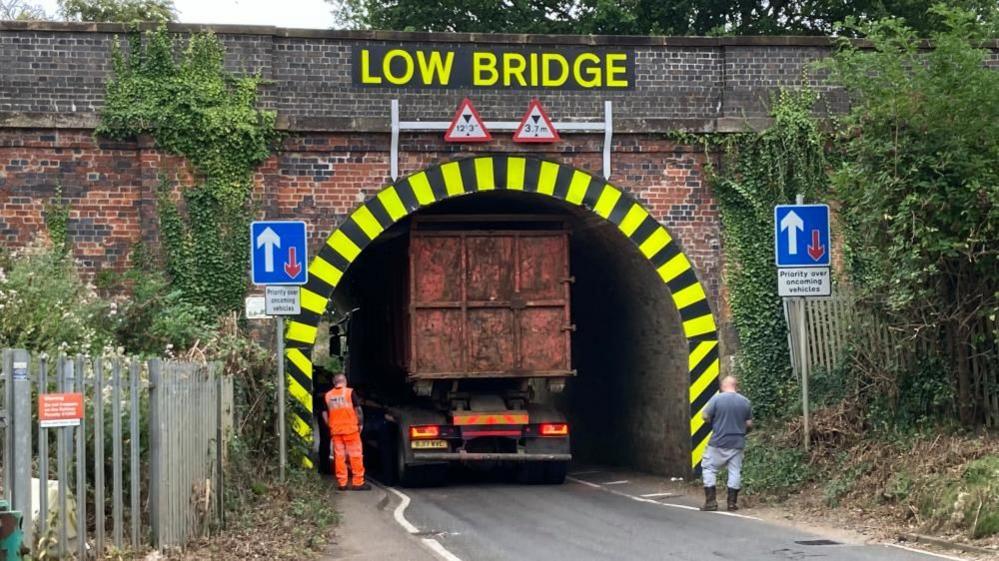 Bridge strikes
Bridge strikes occur when
heavy goods vehicles (HGVs) collide with low bridges, causing severe damage to both the vehicle and the infrastructure. These incidents pose significant
safety risks for drivers and other road users, leading to costly repairs, insurance claims, and traffic disruptions. Bridge strikes have become a growing concern in the UK, highlighting the need for effective strategies to mitigate these risks.
Key Causes of Bridge Strikes
- Height Misjudgement
- Many bridge strikes result from drivers misjudging the height of their vehicle or failing to notice the bridge’s height restrictions.
- Inaccurate Route Planning
- Not accounting for low bridges during route planning can direct vehicles towards dangerous areas.
- Lack of Training
- Drivers without sufficient training regarding vehicle dimensions and height awareness are more prone to errors that can cause bridge strikes.
How to Prevent Bridge Strikes: Essential Strategies
- Height Awareness and Driver Training
- Driver Education: Ensure all drivers are trained on the dimensions of their vehicles and understand the importance of height awareness. This includes being familiar with the vehicle’s height and any loads that may increase it.
- Refresher Courses: Regular training sessions are key to maintaining height awareness among drivers and reinforcing safe driving practices.
- Effective Route Planning
- Use of GPS Technology: Incorporate GPS systems and routing software designed for HGVs. These tools can alert drivers to low bridges and height restrictions, offering alternative routes to avoid accidents.
- Route Familiarization: Encourage drivers to become familiar with their planned routes and any known low bridge hazards before starting their journey.
- Clear Communication and Signage
- Improved Signage: Ensure all low bridges are marked with clear and visible signage, placed well in advance to give drivers time to adjust their routes safely.
- Driver Communication: Establish an internal system for drivers to report low bridges or near misses, allowing other drivers to be alerted to potential dangers.
- Monitoring and Reporting Systems
- Incident Reporting: Set up a system for drivers to report bridge strikes or near-miss incidents. This data can help identify high-risk areas and improve route planning and signage efforts.
- Regular Vehicle Checks: Conduct frequent inspections to ensure vehicles remain within their height limits, especially if additional loads or modifications have been made.
- Collaboration with Local Authorities
- Work with Authorities: Collaborate with local councils and transport authorities to identify problematic low bridges and develop solutions, such as improved signage or infrastructure changes.
- Join Safety Campaigns: Participate in national and local safety campaigns aimed at reducing bridge strikes. These often provide helpful resources and support for fleet operators.
The Financial Impact of Bridge Strikes
The costs associated with bridge strikes can be staggering. According to the
Road Safety Foundation, a single bridge strike can result in over £100,000 in expenses when considering
infrastructure repairs,
traffic disruptions, and
lost revenue. Moreover, repeated incidents can lead to significantly higher
insurance premiums for HGV operators.
Conclusion: Preventing Bridge Strikes with Proactive Measures
Bridge strikes are a significant risk for
HGV operators, but they are largely preventable through
height awareness,
driver training, and effective
route planning. By investing in
GPS technology, improving
communication systems, and collaborating with authorities, fleet operators can greatly reduce the likelihood of these costly and dangerous incidents.
As the road transport industry evolves, focusing on
safety and compliance not only protects vehicles and infrastructure but also boosts
operational efficiency and reduces overall costs.
For more information on preventing bridge strikes, visit the
Road Safety Foundation website. Or for advice, support, training options and post incident tool kits please
contact us here.
 Bridge strikes occur when heavy goods vehicles (HGVs) collide with low bridges, causing severe damage to both the vehicle and the infrastructure. These incidents pose significant safety risks for drivers and other road users, leading to costly repairs, insurance claims, and traffic disruptions. Bridge strikes have become a growing concern in the UK, highlighting the need for effective strategies to mitigate these risks.
Bridge strikes occur when heavy goods vehicles (HGVs) collide with low bridges, causing severe damage to both the vehicle and the infrastructure. These incidents pose significant safety risks for drivers and other road users, leading to costly repairs, insurance claims, and traffic disruptions. Bridge strikes have become a growing concern in the UK, highlighting the need for effective strategies to mitigate these risks.

